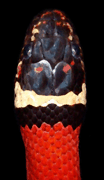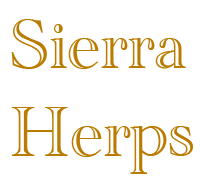
Ruthven’s Kingsnake — Lampropeltis ruthveni Blanchard 1920
Other Common Names: Querétaro Kingsnake
Spanish Name: Coralillo Falso, Culebra Real de Ruthven
Original Description: Blanchard, F. N. 1920. Three new snakes of the genus Lampropeltis. University of Michigan, Occasional Papers of the Museum of Zoology (81):1–10.
Holotype & Type Locality: United States National Museum 46558 (skin and head only), collected by E. W. Nelson on 2 August 1892, from Patzcuaro, Michoacan, Mexico. However, the locality with the type specimen is Potrenaro, Michoacan, while the base camp of the collector (Nelson) was Patzcuaro (Garstka 1982).
Etymology: The species name is a patronym honoring Alexander Grant Ruthven (1882–1971), eminent herpetologist and former President of the University of Michigan. During his tenure as Biology Professor at Michigan, Ruthven served as academic advisor to Blanchard—his first doctoral student. In addition to the kingsnake from Mexico, Pituophis ruthveni (Louisiana Pinesnake) is also named in his honor. Full herpetological biography available in Adler et al. (1989, pp. 74–75).
Scientific Describer: Frank Nelson Blanchard (1888–1937), author of the first monographic treatment of the kingsnakes, the subject of his Ph.D. thesis (1919). In addition to his pioneering work with Lampropeltis, Blanchard published important taxonomic papers on Tantilla (black-headed snakes) and Diadophis (ring-necked snakes), the latter appearing several years after his premature death. His name is associated with a snake (Smooth Greensnake, Opheodrys vernalis blanchardi—a subspecies no longer recognized) and Blanchard’s Cricket Frog (Acris crepitans blanchardi). At the time of his death, Blanchard was Associate Professor of Zoology at the University of Michigan. Full herpetological biography available in Adler et al. (1989, pp. 95–96): “Although he died prematurely at the age of 48, Frank Nelson Blanchard became the leading scholar of North American snakes since the work of Edward D. Cope.” Published obituaries included those by Schmidt (1937) and Gloyd (1940).
Distribution: The northern elements of the Transverse Volcanic Belt (southern part of the Central Plateau), incorporating portions of the southern Sierra Madre Occidental, the southern Sierra Madre Oriental, and various outlier ranges south of the Chihuahuan Desert. Currently known from the Mexican states of Jalisco, Michoacán, Guanajuato, Querétaro, and Hidalgo, although conditions appear suitable for this species to occur in other states. It seems likely that future exploration will extend the known range. Although now known from two sites in Querétaro, L. ruthveni was long overlooked from that’s state herpetofauna, as it is missing from the list of species known to occur in that state as recently as 1972 (Dixon et al. 1972). Most recently, the species has been reported from Guanajuato and Hidalgo. Populations often are associated with isolated mountain ranges or otherwise uplifted regions, which are separated by lower-elevation semiarid landscapes, and thus gene flow between populations apparently no longer occurs.
Habitat: Ruthven’s Kingsnakes are dwellers of elevated, rock-strewn landscapes, from moderately steep slopes to open, gentle terrain. They are closely associated with rock outcrops, which they use for protection, thermoregulation, feeding, and breeding. Often gregarious, with small groups of snakes associated with especially favorable crevices or rock piles. Most have been found by searching boulder crevices or by flipping rocks during the summer rainy season. As with other Mexicana kings, their habitats experience rather cool temperatures even during the summer months, as well as regular afternoon rains during the summer monsoons. Vegetation ranges from oak woodlands through pine-oak associations to mesquite grassland. This is a high-elevation species, ranging from about 5300 to 8800 ft. (1739 – 2681 m), likely the highest elevation for any Mexican Lampropeltis.
Several authors have reported range overlap between L. ruthveni and various subspecies of L. triangulum, without citing vouchers. However, we are not aware of any locality where individuals of both species have been taken. It seems likely that populations of L. triangulum occur in the valleys below the upland sites known to harbor L. ruthveni, and we expect these species to potentially meet in the area south of Laguna de Chapala near the Jalisco-Michoacán border. Future field efforts ought to focus on areas of potential contact involving the L. triangulum subspecies of arcifera, dixoni, smithi, and inland populations of nelsoni.
Growth and Size: In captivity, sexual maturity is reached at 32+ months of age, or at 20 months under a strong feeding regime. Age to maturity is unknown in the wild. Our captives breed from 1–2 months after emergence from winter cooling, but it’s unclear if this pattern reflects the natural cycle. Other breeders have observed copulation at shorter intervals post-brumation. In our collection, ruthveni breed later than leonis or mexicana, despite exposure to the same light/temperature regime. This might be the largest species of the group, with adults approaching and perhaps exceeding 1 m in total length. Clutch sizes for captive females may be as large as 15 eggs; however, given the size and robust condition of most captive-raised females, we suspect that clutch sizes in the wild are smaller. Hatchlings are 7–9 inches (18–22 cm) TL.
Pattern Variation: Compared to other Mexicana kingsnakes, L. ruthveni shows only modest pattern diversity across its range, and even this might simply reflect within-population variation. Common variations relate to head/snout pigmentation: typically all black, but sometimes with red or white flecks or patches. This can even vary within litters. A low percentage of snakes from a Michoacan locality (not represented in captive collections) have tangerine-colored light bands. Adult females, especially those from the eastern part of the range, tend to develop a “graying” of the light crossbands, a trait not evident even in older males. The tricolor pattern in ruthveni follows a trend seen in a number of forms of Lampropeltis, and presumably mimics that of venomous coralsnakes.
Relationships: In the 60+ years following its description, ruthveni remained the most enigmatic of Mexican kingsnakes, known only from the type specimen. Doubts arose as to whether this was even a distinct species. Indeed, Kenneth Williams, in his American milksnake monograph (1978), wiped ruthveni from the taxonomic landscape, placing it in the synonymy of L. triangulum arcifera (Jalisco Milksnake). Additional details concerning the taxonomic history of these snakes are offered under several entries in the Publications list. In 1982, William Garstka identified several diagnostic morphological characters and demonstrated that ruthveni was indeed a distinct species, related to snakes included in L. mexicana rather than pyromelana, zonata, or triangulum. In a study of mtDNA variation (Bryson 2002; Bryson et al. 2005), three specimens of ruthveni spanning the geographic range of the species were sampled. These results revealed only modest mtDNA differences among these range segments, suggestive of recent gene exchange.
Conservation Status: The majority of field experience with L. ruthveni derives from a handful of localities, where the snakes are common. Otherwise, the species is virtually unstudied in the wild. Some of the areas where ruthveni occurs have been modified for agriculture or other human activities, and it seems likely that populations of snakes have been affected, especially in areas where fields have been cleared of stones. The species is listed as “Near Threatened” in IUCN’s Red List of Threatened Species and as “Threatened” by SEMARNAT, ostensibly due to the relatively small known range.
Captive Stock: Virtually all U.S. and European ruthveni in collections are descended from animals originally collected near Amealco, in southwestern Querétaro. The first amelanistic (“albino”) ruthveni was produced from wild-caught stock from Amealco, and L. ruthveni is the only species of Mexicana kingsnake in which amelanism is known to occur, with the possible exception of alterna. In the years since, amelanistic ruthveni have been crossed with leonis, mexicana, alterna, and various forms of triangulum to produce amelanistic hybrids. Although this information has not been published, it is taken as common knowledge among breeders that amelanistic male ruthveni exhibit reduced fertility compared to their wild-type counterparts. Thus, for breeders wishing to produce amelanistic offspring, the most productive pairings are those that involve a heterozygous male with an amelanistic or heterozygous female.
Recently, material from a second population—from Rancho San Francisco, near Tapalpa, Jalisco, on the northern flank of Nevada de Colima, in the western part of the range—has become available to herpetoculturists. For a number of years, these Tapalpa snakes were unwittingly bred and sold as Jalisco Milksnakes (Lampropeltis triangulum arcifera), and are descended from animals originally collected for the Dallas Zoo. We now know these snakes are actually L. ruthveni. Considering the history of taxonomic confusion involving ruthveni and arcifera, this is not surprising.
Several snakes were collected and brought to the U.S. from the mountain area northwest of Jalpan, in eastern Querétaro, during the 1980s. Their identification to species was unclear at the time—they were variously suggested to be L. mexicana, L. triangulum smithi, or L. ruthveni. However, a tissue sample from one of these snakes was incorporated in a published study of mtDNA variation within Mexicana-group snakes by Bryson et al. (2005), and confirmed this Jalpan-area snake as belonging to L. ruthveni. Descendents of the original wild-caught snakes are present in several U.S. collections. Unfortunately, many, if not most of these descendent snakes are hybrids, the result of breeding the Jalpan ruthveni with L. mexicana to produce a more colorful snake.
Line breeding has resulted in snakes that are noticeably brighter, with cleaner markings, than their wild counterparts.
In our collection, L. ruthveni is represented by animals from both the Amealco (Querétaro) and Tapalpa (Jalisco) populations, and we are committed to keeping these lines separate. To date, the amelanism trait has appeared naturally only in Amealco stock.
